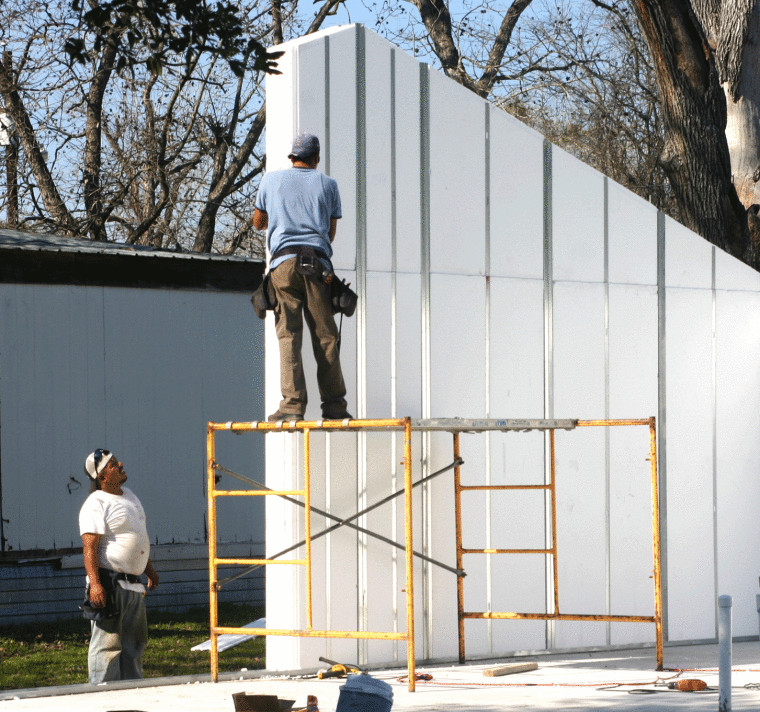Housing boom: Waelder building energy-efficient homes
Waelder is getting some new homes with a new look, and a tinge of energy efficiency that’s easy on the pocketbook.
Thanks to a Neighborhood Stabilization Grant provided by the Texas Department of Housing and Community Affairs, the Austin-based construction company SolidGreen Systems has been contracted to build at least three steel-framed, Styrofoam-insulated houses.
And contractors are close to wrapping things up.
Waelder officials say the three-bedroom, two-bath homes with an estimated value of $100,000 will be offered much cheaper than that as their appraisal will be done based on the values of the surrounding homes within the block.
“Let’s say the neighboring houses average a value of $50,000,” explains Waelder city administrator Avery Williams. “On a 30-year note with no down payment, that’s going to give the person who moves in a $138-a-month mortgage note.”
Byron Phillips, vice president of operations for SolidGreen, recently took a break from the bustling building activity to share information about these works in progress, most notably how “green” they are, and how resilient they are to hungry, invasive termites.
“Our philosophy is to insulate from the outside, using a light gauge steel framing system with an EPS panel that’s integrated into it,” Phillips says of the design. “It is cut to accommodate all of our electrical and plumbing utility chases, and sheet rock hanging.”
Phillips says another goal is to eliminate or reduce thermal bridging as much as possible by heating up material and letting heat infiltrate the home.
“We insulate the framing members so they don’t heat up at all, as opposed to traditional building, which would involve insulating the cavities but in bridges through the framing into the house,” he says.
Phillips says the insulation is comprised of Styrofoam, which has great R-value or thermal efficiency. It has a high compressive strength and resistance to water penetration. In addition, it has higher moisture resistance than any other foam plastic insulation. Therefore, it provides longer and better efficiency, as compared to any other insulation.
“The wall and ceiling are R36 [insulated],” Phillips says. “Typical walls, depending on the city you’re in, are R13 or R19. If we end up with an R36 wall, we end up reducing A/C size by about half. We use a mechanical ventilation system integrated with the air conditioning system that manages the air inside, so you get natural air changes – fresh air inside.”
Phillips says the finished product ends up being a very clean indoor air environment, and a less expensive air conditioning system, resulting in lower energy bills.
“It can differ from one homeowner to the next regarding personal energy use, but as far as heating and cooling goes, we can get as low as 60 percent of traditional home energy costs,” he says.
“We also have a pretty quick build time with these homes,” he continues. “We’ll wind up doing these within 45 days. We’re doing three of them at once. There is a possibility we could do two more in Waelder, but that hasn’t been finalized yet.”
SolidGreen’s crew started framing on Jan. 26, and Phillips says the foundations went in a week or two before that.
“The interior’s finished, and we’re doing the corners right now,” he says. “We’ll come and do a final sealing in a few days, then dry walling a few days after that. We should be wrapped up with these homes between the last week of February and the first week of March.”
Some folks in Waelder have expressed concerns that Styrofoam loves to catch fire, but Phillips staunchly refutes that notion.
“The Styrofoam insulation is non-flammable,” he maintains. “It will melt, but will not support a flame. So the structural integrity of the building is in the steel framing. If you were to hold a blowtorch up to the Styrofoam, it would melt and be flaming where it’s melting. But when you take the torch away, it will self-extinguish.
Phillips says the Styrofoam doesn’t back down from hindrances such as mold and destructive insects.
“It doesn’t support organic growth,” he says. “So it dramatically reduces areas for mold to accumulate. It is not a food source for termites or carpenter ants, so you don’t have to worry about them.”
When asked about the funding for the houses, Phillips says grants have been instrumental in making the project possible.
“The Neighborhood Stabilization Program is a federal program with federal grants managed by the state,” he says. “It is geared toward revitalizing neighborhoods. You take an abandoned or condemned property and turn it into something new for the community. The homeowner will purchase the home at its appraised value, and part of that program is to fund the difference.”
The weather this time of year is much more hospitable to outdoor workers than it is during the summer months, and the guys doing the work, Phillips included, are enjoying the fresh air and the welcoming ambiance of the Waelder community.
“We’re happy to be doing this,” Phillips says. “It feels great out here. The community has been very good to us, and Avery has been fantastic.”
Phillips says SolidGreen manages to stay pretty busy, and that they’re currently working on other projects in Houston, Austin and Kennedy. “We’re doing things like apartment complexes and dentists offices,” he says. “We do all kinds of work.”
Comments







